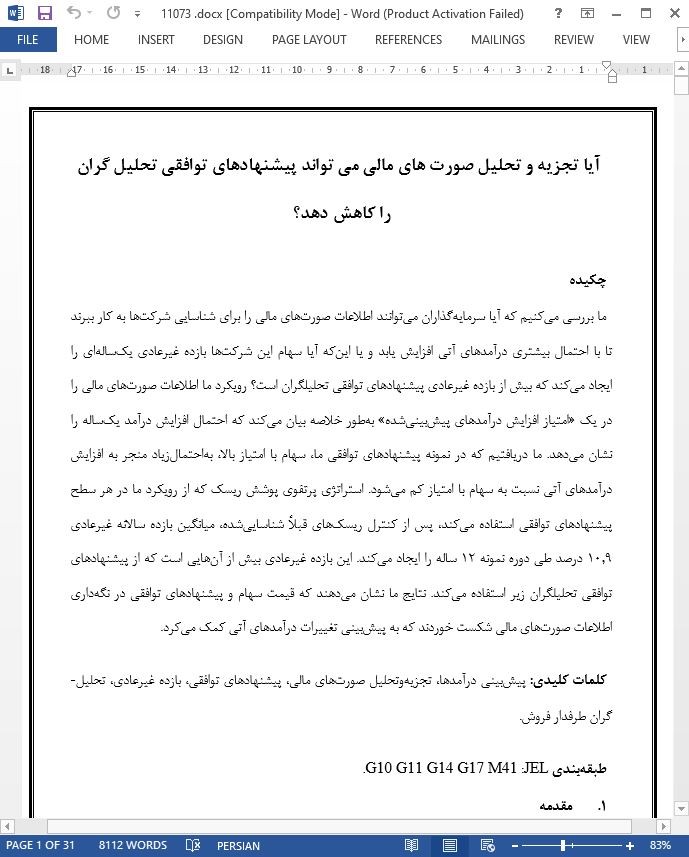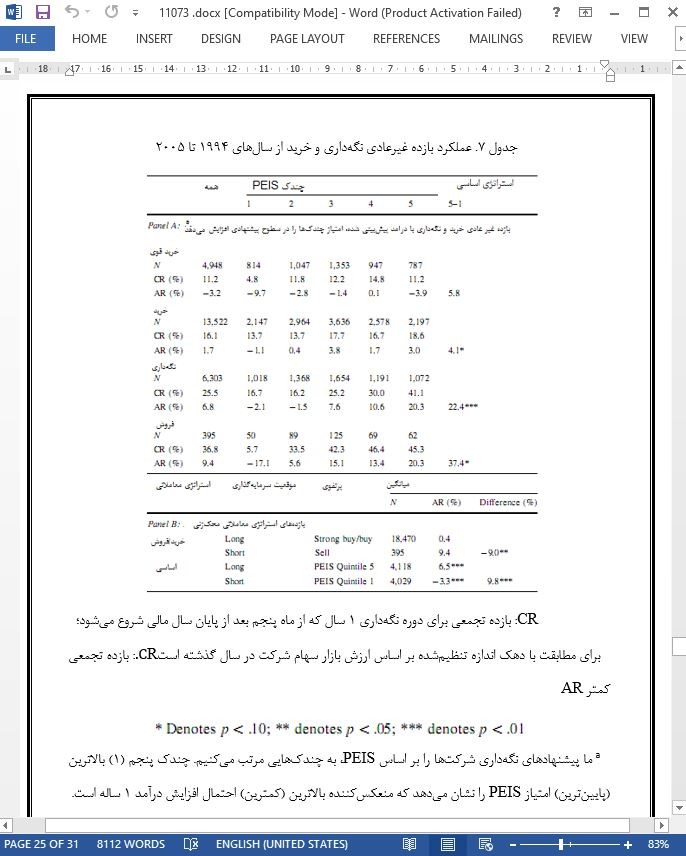
آیا تجزیه و تحلیل صورت های مالی می تواند پیشنهادهای توافقی تحلیل گران را کاهش دهد؟
چکیده
ما بررسی می کنیم که آیا سرمایه گذاران می توانند اطلاعات صورتهای مالی را برای شناسایی شرکت ها به کار ببرند تا با احتمال بیشتری درآمدهای آتی افزایش یابد و یا این که آیا سهام این شرکت ها بازده غیرعادی یکسالهای را ایجاد می کند که بیش از بازده غیرعادی پیشنهادهای توافقی تحلیلگران است؟ رویکرد ما اطلاعات صورتهای مالی را در یک «امتیاز افزایش درآمدهای پیش بینی شده» به طور خلاصه بیان می کند که احتمال افزایش درآمد یکساله را نشان می دهد. ما دریافتیم که در نمونه پیشنهادهای توافقی ما، سهام با امتیاز بالا، بهاحتمالزیاد منجر به افزایش درآمدهای آتی نسبت به سهام با امتیاز کم می شود. استراتژی پرتفوی پوشش ریسک که از رویکرد ما در هر سطح پیشنهادهای توافقی استفاده می کند، پس از کنترل ریسک های قبلاً شناسایی شده، میانگین بازده سالانه غیرعادی 10.9 درصد طی دوره نمونه 12 ساله را ایجاد می کند. این بازده غیرعادی بیش از آن هایی است که از پیشنهادهای توافقی تحلیلگران زیر استفاده می کند. نتایج ما نشان می دهند که قیمت سهام و پیشنهادهای توافقی در نگه داری اطلاعات صورتهای مالی شکست خوردند که به پیش بینی تغییرات درآمدهای آتی کمک می کرد.
1. مقدمه
ما بررسی می کنیم که آیا قیمت سهام و پیشنهادهای توافقی تحلیلگران به طور کامل اطلاعات مربوط بهصورتهای مالی موجود را نشان می دهد. بهطور خاص، ما آزمون می کنیم که آیا سرمایه گذاران می توانند اطلاعات صورتهای مالی را برای پیش بینی تغییرات درآمدهای آتی به کار ببرند و سپس از آن پیش بینی ها برای اجرای استراتژی معاملاتی استفاده کنند که پیشنهادهای توافقی تحلیلگران طرفدار فروش را (خرید قوی، خرید، نگه داری، عملکرد پایین یا فروش) بهبود خواهد بخشید.
4. نتیجه گیری
این مطالعه به بررسی پیشنهادهای توافقی از دیدگاه کاربران در مورد صورت های مالی می پردازد. به طور خاص، ما آزمودیم که آیا می توان اطلاعات پیش بینی های مالی را برای پیش بینی تغییرات درآمد آتی استفاده کنیم و سپس پیش بینی های تغییرات درآمد را جهت اجرای استراتژی معاملاتی برای انتخاب برنده ها و بازنده ها در میان پیشنهادهای توافقی تحلیل گران به کار ببریم. آزمون های ما اساساً برای پاسخ به این پرسش است که آیا پیشنهادهای توافقی تحلیل گران و قیمت های به اشتراک گذاشتهشده، به طور کامل اطلاعات پیش بینی درآمد را در صورت های مالی منعکس می کنند.
Abstract
We examine whether investors can exploit financial statement information to identify companies with a greater likelihood of future earnings increases and whether stocks of those companies generate 1-year abnormal returns that exceed the abnormal returns from following analysts’ consensus recommendations. Our approach summarizes financial statement information into a ‘‘predicted earnings increase score,’’ which captures the likelihood of 1-year-ahead earnings increases. We find that, within our sample of consensus recommendations, stocks with high scores are much more likely to experience future earnings increases than stocks with low scores. A hedge portfolio strategy that utilizes our approach within each consensus recommendation level generates average annual abnormal returns of 10.9 percent over our 12-year sample period, after controlling for previously identified risk factors. These abnormal returns exceed those available from following analysts’ consensus recommendations. Our results show that share prices and consensus recommendations fail to impound financial statement information that helps predict future earnings changes.
1 Introduction
We investigate whether share prices and analysts’ consensus recommendations fully reflect available financial statement information. Specifically, we test whether investors can use financial statement information ex ante to predict future earnings changes and then use those predictions to execute a trading strategy that will outperform sell-side analysts’ consensus recommendations (strong buy, buy, hold, underperform, or sell).
4 Conclusion
This study investigates consensus recommendations from a financial statement users’ perspective. Specifically, we test whether one can use financial statement information ex ante to predict future earnings changes and then use those earnings change predictions to execute a trading strategy to pick winners and losers among consensus analysts’ recommendations. Our tests essentially ask whether analysts’ consensus recommendations and share prices fully reflect the earnings prediction information in financial statements.
چکیده
1. مقدمه
2. منابع دادهها و شرح نمونه
3. تجزیهوتحلیل تجربی و نتایج
3-1. امتیاز افزایش درآمد پیش بینی شده
3-2. پرتفوی و استراتژی های معاملاتی
4. نتیجه گیری
Abstract
1 Introduction
2 Data sources and sample description
3 Empirical analyses and results
3.1 Predicted earnings increase score
3.2 Portfolio and trading strategies
4 Conclusion
- اصل مقاله انگلیسی با فرمت ورد (word) با قابلیت ویرایش
- ترجمه فارسی مقاله با فرمت ورد (word) با قابلیت ویرایش، بدون آرم سایت ای ترجمه
- ترجمه فارسی مقاله با فرمت pdf، بدون آرم سایت ای ترجمه


